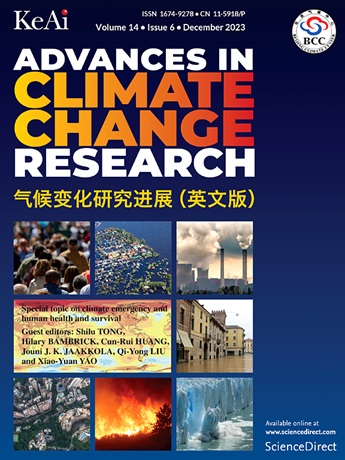2004-2018年澳大利亚各气候带儿童和青少年哮喘风险的地理趋势
IF 6.4
1区 地球科学
Q1 ENVIRONMENTAL SCIENCES
引用次数: 0
摘要
尽管澳大利亚儿童和青少年哮喘患病率存在已知的区域差异,但地理位置、气候多样性和哮喘风险模式之间的复杂相互作用仍未得到充分探讨。本研究通过分析澳大利亚儿童纵向研究的数据,研究了2004-2018年儿童和青少年哮喘患病率的空间模式,该数据根据Köppen-Geiger气候分类系统进行分类,该系统整合了温度、湿度和降水模式等环境因素,以代表更广泛的气候条件。采用空间聚类、调查加权logistic回归、分类回归树分析等方法确定区域特异性危险因素。结果表明,澳大利亚东南部的BSk(干旱、草原、寒冷)、Cfa(温带、无旱季、夏季炎热)和Cfb(温带、无旱季、夏季温暖)气候具有明显的“高-高”集聚区。男童(优势比(OR): 1.27;95%可信区间(CI): 1.06-1.52)与母亲抑郁(OR: 1.40;95% CI: 1.16-1.69)和父母哮喘史(OR: 2.96;95% CI: 2.58-3.41)显示风险显著增加,而母乳喂养超过6个月的风险相应降低(OR: 0.73;95% ci: 0.62-0.86)。在Cfa区观察到“低-低”簇。风险因素的重要性因气候区而异,哺乳时间在热带草原地区最为显著,2岁在一些地区成为关键阈值。这些发现能够更精确地识别高危人群和气候敏感地区,支持有针对性的预防策略和基于气候的早期预警系统的发展,这将提高哮喘管理的有效性,减轻澳大利亚的医疗负担。本文章由计算机程序翻译,如有差异,请以英文原文为准。
Geographic trends in asthma risk among children and adolescents across climate zones in Australia, 2004–2018
Despite the known regional variations in childhood and adolescent asthma prevalence across Australia, the complex interactions between geographic location, climate diversity, and asthma risk patterns remain critically underexplored. This study examined spatial patterns of asthma prevalence among children and adolescents (2004–2018) by analysing data from the Longitudinal Study of Australian Children, categorized according to the Köppen-Geiger climate classification system, which integrates environmental factors such as temperature, humidity, and precipitation patterns to represent broader climatic conditions. We employed spatial clustering, survey-weighted logistic regression, and classification and regression tree analysis to identify region-specific risk factors. Results revealed distinct spatial patterns with ‘high-high’ clusters concentrated in southeastern Australia’s BSk (arid, steppe, cold), Cfa (temperate, no dry season, hot summer), and Cfb (temperate, no dry season, warm summer) climate. Male children (odds ratio (OR): 1.27; 95% confidence interval (CI): 1.06–1.52) with maternal depression (OR: 1.40; 95% CI: 1.16–1.69) and a parental asthma history (OR: 2.96; 95% CI: 2.58–3.41) showed significantly elevated risk, while breastfeeding beyond six months corresponded with reduced risk (OR: 0.73; 95% CI: 0.62–0.86). ‘Low-low’ clusters were observed in the Cfa zone. Risk factor importance varied by climate zone, with breastfeeding duration being most notable in the Aw (tropical, savannah) zone and age 2 emerging as a key threshold in several zones. These findings enable more precise identification of high-risk populations and climate-sensitive regions, supporting the development of targeted preventive strategies and climate-based early warning systems that will enhance asthma management effectiveness and reduce healthcare burdens across Australia.
求助全文
通过发布文献求助,成功后即可免费获取论文全文。
去求助
来源期刊

Advances in Climate Change Research
Earth and Planetary Sciences-Atmospheric Science
CiteScore
9.80
自引率
4.10%
发文量
424
审稿时长
107 days
期刊介绍:
Advances in Climate Change Research publishes scientific research and analyses on climate change and the interactions of climate change with society. This journal encompasses basic science and economic, social, and policy research, including studies on mitigation and adaptation to climate change.
Advances in Climate Change Research attempts to promote research in climate change and provide an impetus for the application of research achievements in numerous aspects, such as socioeconomic sustainable development, responses to the adaptation and mitigation of climate change, diplomatic negotiations of climate and environment policies, and the protection and exploitation of natural resources.
 求助内容:
求助内容: 应助结果提醒方式:
应助结果提醒方式:


